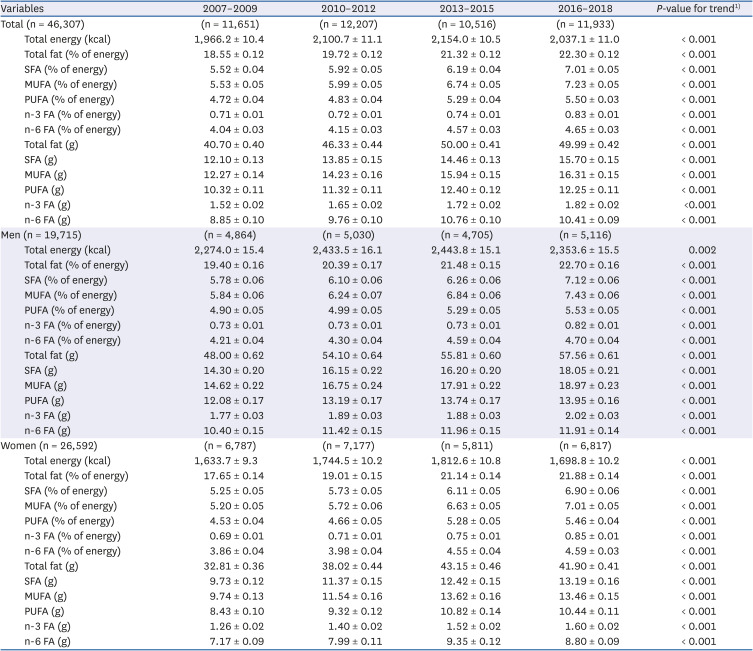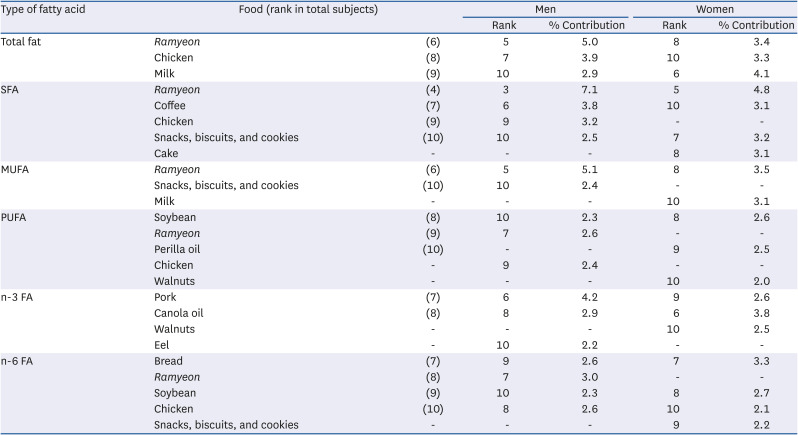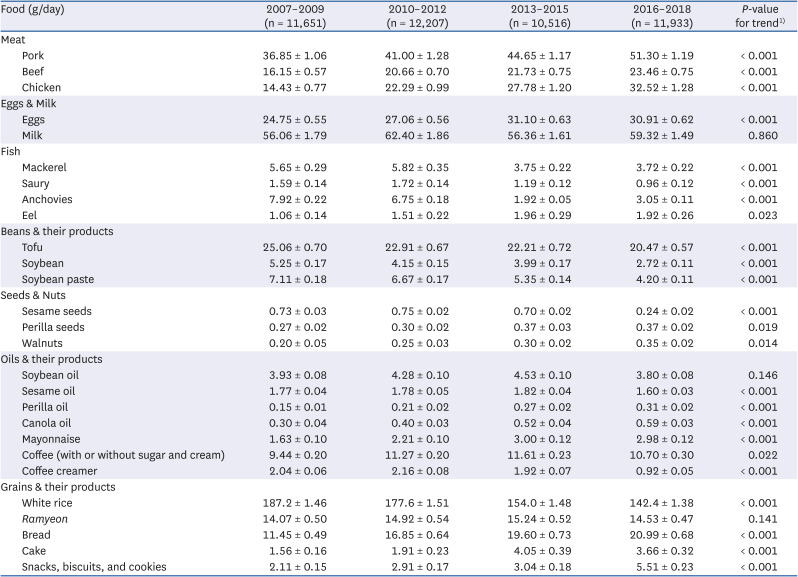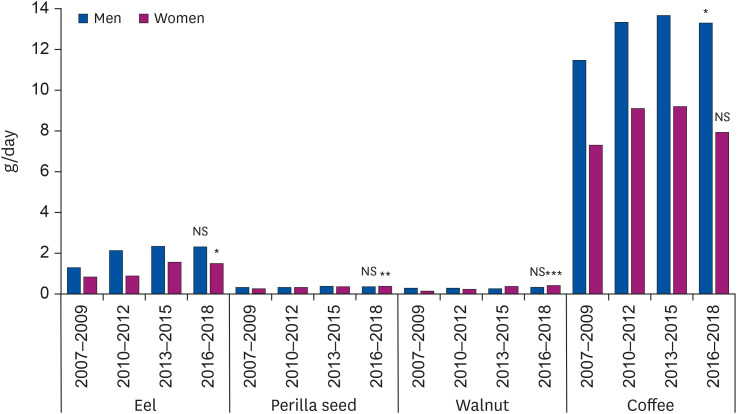1. Food and Agriculture Organization of the United Nations (FAO). Fats and Fatty Acids in Human Nutrition. Report of an Expert Consultation. Rome: FAO;2010.
2. de Oliveira Otto MC, Mozaffarian D, Kromhout D, Bertoni AG, Sibley CT, Jacobs DR Jr, Nettleton JA. Dietary intake of saturated fat by food source and incident cardiovascular disease: the multi-ethnic study of atherosclerosis. Am J Clin Nutr. 2012; 96:397–404. PMID:
22760560.
3. Eilander A, Harika RK, Zock PL. Intake and sources of dietary fatty acids in Europe: are current population intakes of fats aligned with dietary recommendations? Eur J Lipid Sci Technol. 2015; 117:1370–1377. PMID:
26877707.
4. Harrison S, Brassard D, Lemieux S, Lamarche B. Dietary saturated fats from different food sources show variable associations with the 2015 Healthy Eating Index in the Canadian population. J Nutr. 2020; 150:3288–3295. PMID:
33188403.
5. Huth PJ, Fulgoni VL 3rd, Keast DR, Park K, Auestad N. Major food sources of calories, added sugars, and saturated fat and their contribution to essential nutrient intakes in the U.S. diet: data from the National Health and Nutrition Examination Survey (2003–2006). Nutr J. 2013; 12:116. PMID:
23927718.
6. Kirkpatrick SI, Raffoul A, Lee KM, Jones AC. Top dietary sources of energy, sodium, sugars, and saturated fats among Canadians: insights from the 2015 Canadian Community Health Survey. Appl Physiol Nutr Metab. 2019; 44:650–658. PMID:
30951373.
7. Joyce T, Wallace AJ, McCarthy SN, Gibney MJ. Intakes of total fat, saturated, monounsaturated and polyunsaturated fatty acids in Irish children, teenagers and adults. Public Health Nutr. 2009; 12:156–165. PMID:
19026091.
8. Sioen I, Vyncke K, De Maeyer M, Gerichhausen M, De Henauw S. Dietary intake and food sources of total and individual polyunsaturated fatty acids in the Belgian population over 15 years old. Lipids. 2013; 48:729–738. PMID:
23588778.
9. Shen X, Fang A, He J, Liu Z, Guo M, Gao R, Li K. Trends in dietary fat and fatty acid intakes and related food sources among Chinese adults: a longitudinal study from the China Health and Nutrition Survey (1997–2011). Public Health Nutr. 2017; 20:2927–2936. PMID:
28789722.
10. Vadiveloo M, Scott M, Quatromoni P, Jacques P, Parekh N. Trends in dietary fat and high-fat food intakes from 1991 to 2008 in the Framingham Heart Study participants. Br J Nutr. 2014; 111:724–734. PMID:
24047827.
11. Song S, Shim JE, Song WO. Trends in total fat and fatty acid intakes and chronic health conditions in Korean adults over 2007–2015. Public Health Nutr. 2019; 22:1341–1350. PMID:
30767815.
12. Song S, Shim JE. Evaluation of total fat and fatty acids intakes in the Korean adult population using data from the 2016–2017 Korea National Health and Nutrition Examination Surveys. Korean J Community Nutr. 2019; 24:223–231.
13. Song S, Shim JE. Trends in dietary intake of total fat and fatty acids among Korean adolescents from 2007 to 2017. Nutrients. 2019; 11:3073.
14. Kweon S, Kim Y, Jang MJ, Kim Y, Kim K, Choi S, Chun C, Khang YH, Oh K. Data resource profile: the Korea National Health and Nutrition Examination Survey (KNHANES). Int J Epidemiol. 2014; 43:69–77. PMID:
24585853.
15. Yoon MO, Kim K, Hwang JY, Lee HS, Son TY, Moon HK, Shim JE. Development of a fatty acids database using the Korea National Health and Nutrition Examination Survey data. J Nutr Health. 2014; 47:435–442.
16. Li K, McNulty BA, Tiernery AM, Devlin NF, Joyce T, Leite JC, Flynn A, Walton J, Brennan L, Gibney MJ, et al. Dietary fat intakes in Irish adults in 2011: how much has changed in 10 years? Br J Nutr. 2016; 115:1798–1809. PMID:
26996058.
17. Pot GK, Prynne CJ, Roberts C, Olson A, Nicholson SK, Whitton C, Teucher B, Bates B, Henderson H, Pigott S, et al. National Diet and Nutrition Survey: fat and fatty acid intake from the first year of the rolling programme and comparison with previous surveys. Br J Nutr. 2012; 107:405–415. PMID:
21767448.
18. Lee HS, Duffey KJ, Popkin BM. South Korea's entry to the global food economy: shifts in consumption of food between 1998 and 2009. Asia Pac J Clin Nutr. 2012; 21:618–629. PMID:
23017321.
19. Guasch-Ferré M, Babio N, Martínez-González MA, Corella D, Ros E, Martín-Peláez S, Estruch R, Arós F, Gómez-Gracia E, Fiol M, et al. Dietary fat intake and risk of cardiovascular disease and all-cause mortality in a population at high risk of cardiovascular disease. Am J Clin Nutr. 2015; 102:1563–1573. PMID:
26561617.
20. Widmer RJ, Flammer AJ, Lerman LO, Lerman A. The Mediterranean diet, its components, and cardiovascular disease. Am J Med. 2015; 128:229–238. PMID:
25447615.
21. Fung TT, Willett WC, Stampfer MJ, Manson JE, Hu FB. Dietary patterns and the risk of coronary heart disease in women. Arch Intern Med. 2001; 161:1857–1862. PMID:
11493127.
22. Fung TT, Chiuve SE, McCullough ML, Rexrode KM, Logroscino G, Hu FB. Adherence to a DASH-style diet and risk of coronary heart disease and stroke in women. Arch Intern Med. 2008; 168:713–720. PMID:
18413553.
23. Jayedi A, Shab-Bidar S, Eimeri S, Djafarian K. Fish consumption and risk of all-cause and cardiovascular mortality: a dose-response meta-analysis of prospective observational studies. Public Health Nutr. 2018; 21:1297–1306. PMID:
29317009.
24. Kim YS, Xun P, He K. Fish consumption, long-chain omega-3 polyunsaturated fatty acid intake and risk of metabolic syndrome: a meta-analysis. Nutrients. 2015; 7:2085–2100. PMID:
25811108.
25. Marventano S, Izquierdo Pulido M, Sánchez-González C, Godos J, Speciani A, Galvano F, Grosso G. Legume consumption and CVD risk: a systematic review and meta-analysis. Public Health Nutr. 2017; 20:245–254. PMID:
28077199.
26. Anderson TJ, Grégoire J, Pearson GJ, Barry AR, Couture P, Dawes M, Francis GA, Genest J Jr, Grover S, Gupta M, et al. 2016 Canadian Cardiovascular Society guidelines for the management of dyslipidemia for the prevention of cardiovascular disease in the adult. Can J Cardiol. 2016; 32:1263–1282. PMID:
27712954.
27. Rhee EJ, Kim HC, Kim JH, Lee EY, Kim BJ, Kim EM, Song Y, Lim JH, Kim HJ, Choi S, et al. 2018 Guidelines for the management of dyslipidemia. Korean J Intern Med. 2019; 34:723–771. PMID:
31272142.
28. Arnett DK, Blumenthal RS, Albert MA, Buroker AB, Goldberger ZD, Hahn EJ, Himmelfarb CD, Khera A, Lloyd-Jones D, McEvoy JW, et al. 2019 ACC/AHA guideline on the primary prevention of cardiovascular disease: a report of the American College of Cardiology/American Heart Association task force on clinical practice guidelines. Circulation. 2019; 140:e596–e646. PMID:
30879355.
29. Kinoshita M, Yokote K, Arai H, Iida M, Ishigaki Y, Ishibashi S, Umemoto S, Egusa G, Ohmura H, Okamura T, et al. Japan Atherosclerosis Society (JAS) guidelines for prevention of atherosclerotic cardiovascular diseases 2017. J Atheroscler Thromb. 2018; 25:846–984. PMID:
30135334.
30. Mach F, Baigent C, Catapano AL, Koskinas KC, Casula M, Badimon L, Chapman MJ, De Backer GG, Delgado V, Ference BA, et al. 2019 ESC/EAS guidelines for the management of dyslipidaemias: lipid modification to reduce cardiovascular risk. Eur Heart J. 2020; 41:111–188. PMID:
31504418.
31. Ericson U, Hellstrand S, Brunkwall L, Schulz CA, Sonestedt E, Wallström P, Gullberg B, Wirfält E, Orho-Melander M. Food sources of fat may clarify the inconsistent role of dietary fat intake for incidence of type 2 diabetes. Am J Clin Nutr. 2015; 101:1065–1080. PMID:
25832335.









 PDF
PDF Citation
Citation Print
Print



 XML Download
XML Download